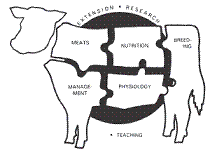Animal Science, Department of

Nebraska Beef Cattle Reports
Date of this Version
2020
Citation
The Board Regents of the University of Nebraska. All rights reserved.
Abstract
During dry- aging, water is transferred from the interior to the meat surface and is subsequently evaporated to the surrounding environment. Th ere is a common belief in the meat industry that rapid drying creates a hard crust on the meat surface, which would act as a protective barrier against moisture loss, holding moisture on the inside of the product. Th is phenomenon is called case hardening. If this hypothesis is correct, drying at low relative humidity would be recommended in order to get case hardening and avoid excessive yield loss. Th is study was conducted to evaluate the effects of relative humidity on moisture loss and flavor in dry- aged beef. No case hardening effects occurred, even at 50% relative humidity. Results suggest lower relative humidity results in more rapid moisture loss at the beginning of the aging process without significantly affecting the total amount of moisture loss. Lower relative humidity tended to associate with more desirable flavor notes.
Included in
Large or Food Animal and Equine Medicine Commons, Meat Science Commons, Veterinary Preventive Medicine, Epidemiology, and Public Health Commons


Comments
2020 Nebraska Beef Cattle Report